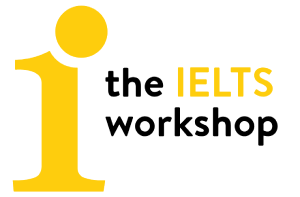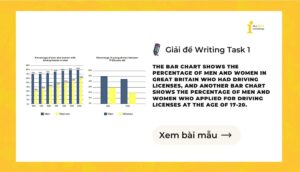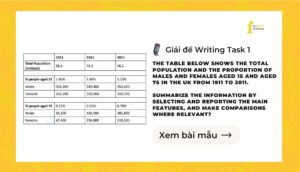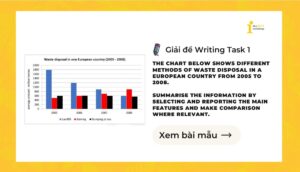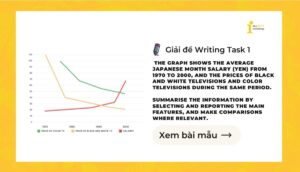Advertising and its impact là một chủ đề quen thuộc trong IELTS Writing Task 2, thường yêu cầu người viết đánh giá ảnh hưởng của quảng cáo đến tư duy và lối sống. Trong bài viết này, thầy Đào Đình Tân từ The IELTS Workshop sẽ giúp bạn tiếp cận chủ đề này một cách logic, từ đó phát triển lập luận rõ ràng và thuyết phục.
1. Phân tích
1.1. Đề bài Advertising and its impact | IELTS Writing Task 2
People are surrounded by all types of advertisements. This both affects what people think is important and has a negative impact on people’s lives. To what extent do you agree or disagree?
(Ngày nay, mọi người thường được bao quanh bởi các thể loại quảng cáo khác nhau. Điều này vừa tác động tich cực lên suy nghĩa của họ, đồng thời cũng gây ra một số ảnh hưởng tiêu cực. Bạn có đồng ý với ý kiến này không?)
1.2. Phân tích đề bài
Dạng bài: Opinion (To what extent do you agree or disagree?)
Từ khóa chính:
- Advertisements: ads, commercials, promotional content
- Affect what people think is important: influence values / priorities
- Negative impact: harmful effects, consequences
Yêu cầu đề bài:
- Đưa ra mức độ đồng tình hoặc không đồng tình
- Lập luận rõ ràng để bảo vệ quan điểm
Xem thêm: Học cách làm dạng Balanced Opinion Essay trong IELTS Writing
1.3. Dàn bài chi tiết
Introduction:
- Câu mở đầu: Nhận định chung về việc con người đang bị bao quanh bởi quảng cáo trên nhiều nền tảng.
- Paraphrase đề bài: Nêu hai ảnh hưởng chính của quảng cáo – ảnh hưởng tới suy nghĩ về điều quan trọng và tác động tiêu cực.
- Thesis statement: Nêu rõ quan điểm (đồng ý hoàn toàn) và định hướng bài viết.
Body Paragraph 1 – Quảng cáo ảnh hưởng đến những gì con người cho là quan trọng
Luận điểm 1: Liên hệ giá trị bản thân với vật chất
- Quảng cáo khiến người ta tin rằng sản phẩm thể hiện đẳng cấp và thành công.
- Ví dụ: Quần áo hàng hiệu, ô tô sang trọng = giá trị bản thân.
- Hệ quả: Con người xa rời các giá trị nhân văn như lòng tốt, giáo dục, sự trung thực.
Luận điểm 2: Lặp đi lặp lại khiến thông điệp trở thành “chuẩn mực xã hội”
- Việc quảng cáo xuất hiện nhiều trên mọi nền tảng khiến mọi người tiếp thu, chấp nhận thông điệp không tốt trong quảng cáo, coi đó là lẽ thường tình. (Chuẩn mực vẻ đẹp không thực tế, thành công phải gắn liền với vật chất, etc.)
- Xã hội dần chấp nhận các giá trị vật chất là quan trọng, thay đổi nhận thức cộng đồng.
Body Paragraph 2 – Quảng cáo ảnh hưởng tiêu cực đến cuộc sống
Luận điểm 1: Khuyến khích tiêu dùng quá mức → áp lực tài chính
- Tạo nhu cầu giả, thúc đẩy mua sắm không cần thiết.
Luận điểm 2: Tạo áp lực tâm lý và cảm giác không rằng bản thân không đủ tốt
- Ví dụ: Quảng cáo mỹ phẩm khiến người xem thấy mình không đủ đẹp → tự ti, stress.
- Quảng cáo khai thác nỗi sợ và thiếu tự tin để tăng doanh thu.
Conclusion
- Khẳng định lại quan điểm: Quảng cáo làm thay đổi giá trị cá nhân và xã hội, và gây ra nhiều ảnh hưởng tiêu cực.
- Đề xuất giải pháp: Nâng cao nhận thức, lựa chọn có ý thức trước ảnh hưởng thương mại.
2. Bài mẫu chủ đề Advertising and its impact (Sample)
In the modern world, people are constantly exposed to advertisements across a wide range of platforms, from social media and television to billboards and mobile apps. Some argue that this overwhelming presence of advertising not only influences people’s sense of priorities but also has harmful consequences for individuals and society. I fully agree with this view, as advertising shapes what people believe is important and contributes to a variety of negative outcomes.
Advertising significantly influences what people perceive as important for two main reasons. Firstly, it often links personal worth with consumer goods. Many advertisements suggest that owning certain products, such as designer clothing, luxury cars, or the latest technology, is a reflection of success, attractiveness, or social status. This manipulative messaging can lead individuals to equate self-value with material possessions, shifting their focus away from more meaningful values like education, kindness, or integrity. Secondly, the sheer volume and repetition of these messages, often promoting material success, unrealistic standards of beauty, or social status through consumption, contribute to their perceived truth. When people are constantly exposed to similar ideas across multiple platforms, they begin to internalize these messages as societal norms. Over time, the collective mindset shifts, and what was once considered excessive or superficial becomes widely accepted as the standard. In this way, advertising not only affects individual thinking but also reshapes cultural values and priorities.
Beyond distorting people’s values, advertising also causes tangible harm in people’s daily lives. For one, it promotes consumerism by encouraging individuals to make impulsive purchases, often for items they do not genuinely need. Through persuasive techniques such as emotional appeal, celebrity endorsements, and exaggerated claims, advertisements create a false sense of need and urgency. As a result, many individuals, especially younger consumers, are drawn into buying items impulsively, which can lead to unnecessary financial strain and long-term spending habits that are difficult to break. Additionally, advertisements frequently exploit insecurities—particularly those related to appearance or lifestyle—causing emotional distress and a persistent sense of inadequacy. For instance, beauty ads commonly promote unrealistic standards, pressuring individuals to conform and spend excessively in the process.
In conclusion, I strongly agree that advertising affects what people consider important and has a largely negative impact on their lives. Through persuasive and repetitive messaging, it reshapes personal and societal values, encourages unhealthy behaviors, and contributes to both psychological and financial harm. Greater awareness of these effects is essential in helping individuals make more conscious choices in a world saturated with commercial influence.
Sample by Dao Dinh Tan – IELTS Teacher at The IELTS Workshop
3. Từ vựng chủ đề Advertising and its impact (Vocabulary)
- Be exposed to (cụm động từ): tiếp xúc với
- Presence (danh từ): sự hiện diện
- A reflection of (cụm danh từ): một sự phản ánh của
- Link personal worth with consumer goods: liên hệ giá trị bản thân với hàng hóa tiêu dùng
- Manipulative messaging (cụm danh từ): thông điệp mang tính thao túng
- Reshape cultural values (cụm động từ): định hình lại các giá trị văn hóa
- Tangible harm (cụm danh từ): tác hại hữu hình, tác hại rõ rệt
- Promote consumerism (cụm động từ): thúc đẩy chủ nghĩa tiêu dùng
- Financial strain (cụm danh từ): gánh nặng tài chính
- Exploit insecurities (cụm động từ): khai thác (lợi dụng) sự tự ti, thiếu tự tin
- Persistent sense of inadequacy (cụm danh từ): cảm giác thiếu sót (không đủ tốt) kéo dài
- Unrealistic standards (cụm danh từ): các tiêu chuẩn phi thực tế
Xem thêm: Tổng hợp 30+ cụm từ và từ vựng chủ đề Advertising nâng cao
Tạm kết
Hy vọng bài viết của thầy Đào Đình Tân đã giúp bạn nắm được cách triển khai hiệu quả cho chủ đề Advertising and its impact trong IELTS Writing Task 2. Đừng quên theo dõi chuyên mục Tổng hợp đề thi IELTS Writing 2025 kèm bài mẫu và tham gia HỌC IELTS MIỄN PHÍ cùng The IELTS Workshop nhé!
Học IELTS 0 ĐỒNG ngay tại HỌC IELTS MIỄN PHÍ cùng các thầy cô tại The IELTS Workshop nhé !

